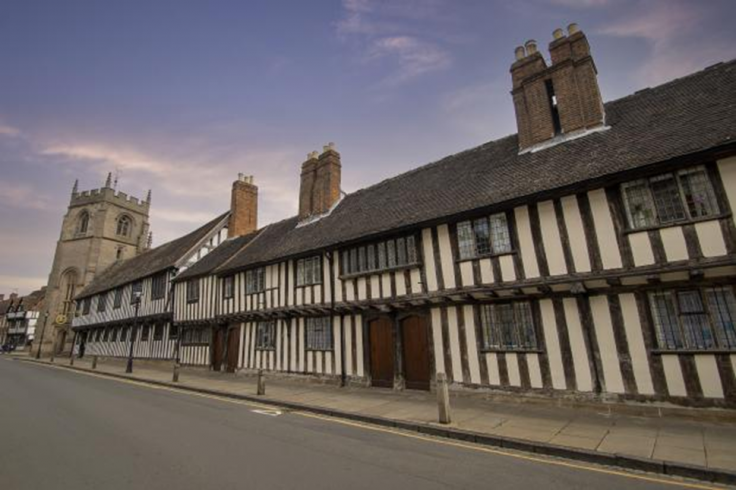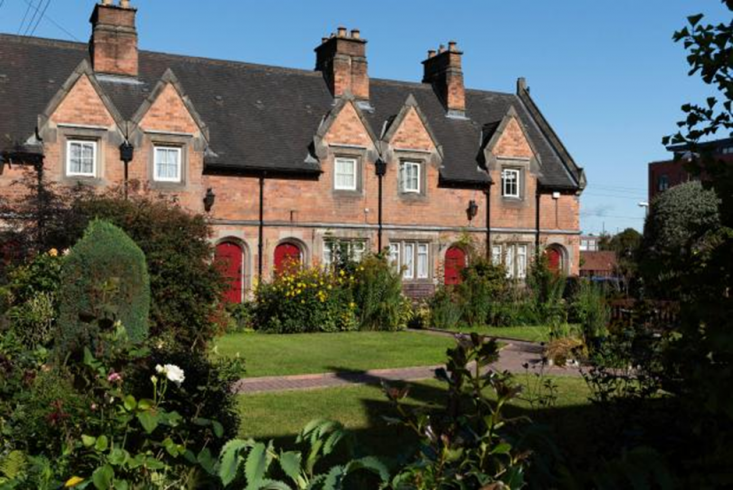Writer for Great British Life, Louise Jones, discovers how Derby’s oldest charity is evolving to meet modern needs and explores why Derby’s almshouses are still important today.
Published 21st March 2023
[Top image: Liversage Almshouses, London Road, Derby (Image: Flickr, (CC BY 2.0))]
‘The Liversage Trust has the distinction of being Derby’s oldest charity.
Established in 1529 during the reign of Henry VIII by Robert Liversage, a Derby businessman, the Trust is an Almhouses Charity which offers accommodation, care and grants to Derby residents in need.
The history of almshouses can be traced all the way back to medieval times, when religious orders were responsible for cared for the poor. Originally known as ‘bede houses’, the oldest almshouse foundation still in existence is believed to be the Hospital of St Oswald in Worcester, founded circa 990. By the mid-1500s, around 800 bede houses were in existence across the country, however Henry VIII’s dissolution of the monasteries meant many were either sold to landowners or simply left to ruin.
Derbyshire’s Liversage Trust has come a long way since its formation in Tudor times.
Now, nearly half a millennium later, it has a varied, well managed, professional property portfolio comprising 160 Almshouses, a 40-bed care home and a variety of commercial units and residential properties across the city of Derby that provide the charity with a steady and consistent income stream to enable its continuity.
As you’d expect from a charity with such history in the local area, the Trust makes a significant contribution to Derby’s proud heritage. It has maintained almshouses in the area since the 17th century, including many important and historically-significant buildings, but most of the homes within its portfolio were built in the 1900s.
This portfolio has now been managed, conserved and developed by Matthew Montague Architects for over four decades; initially by Montague Architects and subsequently by Matthew Montague Architects.
Paul McLocklin, now consultant architect with Matthew Montague Architects, has been working with The Trust for much of that time. In 1976, Paul was the architect responsible for an extensive refurbishment programme of the Trust’s Nottingham Road Estate. Little did he know that, 40 years later, he would lead the team to complete another refurbishment of the same estate which is now one of the city’s most important conservation areas.
Paul was again integral to another project of note, the conversion of the former Liversage Arms into apartments in 2012. At this time, the public house was disused and in a very poor state of repair. Yet it was, and remains, an important element of the Nottingham Road Estate. An extensive restoration programme saw the building converted into six apartments and the conversion received several prestigious conservation awards.
 Almshouses have existed across England since Tudor times (Image: Rob Atherton/Getty Images Plus)
Almshouses have existed across England since Tudor times (Image: Rob Atherton/Getty Images Plus)
Following the successful completion of this scheme, another building on Nottingham Road was converted, creating a further eight units, which was completed in 2017.
“The Liversage Trust was my first job, I was a junior with T.H. Thorpe & Partners at the time,” says Paul. “It has been a real privilege to see The Trust – so important to Derby – develop and grow over the years and I am proud to have played a part. Some of the jobs have not been without their challenges but I wouldn’t change a thing, it is a fantastic institute within the city.”
The flagship London Road Almhouses, constructed in 1836, are Grade II listed and are landmark buildings within Derby. In order to preserve and enhance these important listed buildings, they are naturally subject to strict restrictions and conditions for maintenance, repair and restoration. The homes remain in high demand and occupancy levels are consistently at 100%. However, the needs of clients are changing and The Trust is invested in preserving the properties for the future.
To that end, last year was a milestone year for the charity, with the Board of Trustees agreeing to explore renovation works for the city’s Almshouses.
 London Road almshouses (Image: Matthew Montague Architects)
London Road almshouses (Image: Matthew Montague Architects)
“London Road is a flagship site for The Trust, it was built in the 1830s and has provided homes for Derby residents for a long time”, adds Andy Mellors, general manager at The Trust, “however, expectations and requirements have changed. We want to be able to continue to rent the houses and in order to do that, we need to modernise and improve them for the next 100 years.”
The cottages, for example, currently have steep, narrow stairs, small kitchens that can’t be equipped with washing machines (the facilities are currently communal) as well as out-dated heating systems.
Ashbourne-based Matthew Montague Architects (MMA) have completed feasibility works to evaluate the possibilities and future proof the homes. The exterior of the buildings cannot be changed. Designs and plans have been compiled to reconfigure the internals of the properties, reducing the number of units whilst making significant improvements, offering residents more space.
MMA are currently working with Historic England on all stages of the project prior to any pre-app being submitted to Derby City Council.
“London Road is an important part of Derby’s heritage,” says Matthew Montague. “Though the works are complicated, they will preserve the almshouses for the future’”
Many years ago, the same site had its own mortuary, now the main offices for The Trust. In order to not reduce the number of homes available on London Road, the proposed plans will convert these buildings and the communal laundry into bungalows; reducing only slightly the amount of accommodation available overall.
Plans are now afoot to convert the current offices, which will see the offices relocate to Alice Street, part of the Nottingham Road Estate, where The Trust currently has a workshop.
With the Trust currently employing 55 people, the new offices will also allow it to potentially expand the team and grow resources.
Planning Permission has been granted by Derby City Council to convert the existing workshop/storage buildings on Alice Street into offices, a new workshop and stores for the Trust’s maintenance team, including demolition of the storage building to the east of the site and the construction of a parking courtyard.
The existing building will be converted sympathetically with its original appearance, maintaining the character of the conservation area by the careful selection of replacement windows and doors, matching slate roof and reuse of existing openings where possible.
 The gates to the current Liverage Trust offices (Image: Flickr, (CC BY 2.0))
The gates to the current Liverage Trust offices (Image: Flickr, (CC BY 2.0))
As well as its undoubted legacy, the Trust is also for the here and now.
It offers grants to those in need of financial support, with the current cost of living crisis significantly increasing demand, with the new offices enhancing its ability to respond to the rising demand for support.
“The pandemic was a difficult time, we continued working and protected our residents and clients as best we could, although we did see a decrease in demand for our services,” concludes Andy Mellors, general manager at the Liverage Trust.
“The cost of living crisis on the other hand has seen a massive increase in demand for services and grants, and we significantly increased the number of grants given in 2022.”
“The stronger the Trust is, the more capable we are to help more people. These developments are all key parts of the plan to strengthen our future. Plans do not stop there. We have ambitious longer-term plans too, with a commitment to increasing the number of almshouses in our portfolio, and feasibility studies have been prepared for other sites the Trust owns. It’s an exciting time for the Trust.”‘